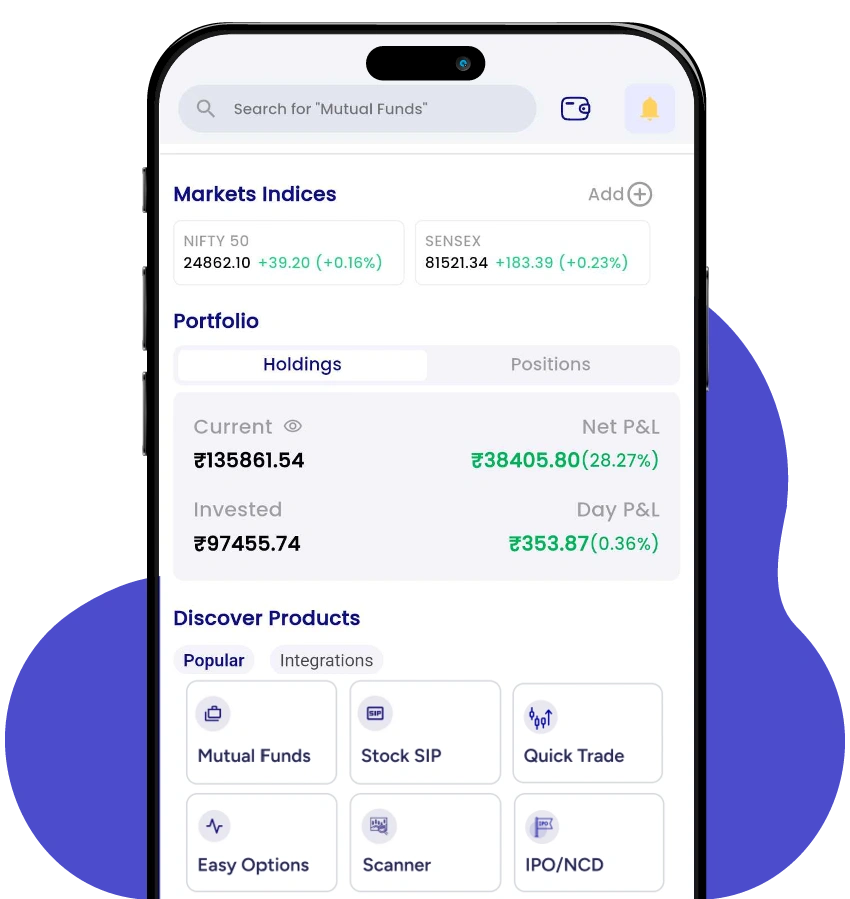What is SIP (Systematic Investment Plan)?
- 14th October 2025
- 11:00 AM
- 8 min read
New to mutual fund investments and worrying if it is worth it? The Indian mutual fund industry in 2025 added 4 lakh new investors in mutual funds, showing the interest of Indians towards it. Before you invest, you must learn what is SIP, and it is simply an investment mode in a mutual fund that allows you to invest a fixed amount monthly. Read this blog to learn more.
How Does SIP Work?
Suppose you choose a mutual fund with a 12% annualised return and choose an SIP of INR 12,000 per month for 1 year. The Net Asset Value of the fund is at INR 100 per unit, which allows an initial allocation of 120 units. Here is a detailed view of how allocation might change and potential return:
| Month | SIP amount (INR) | Current NAV | Allocated Units | Total Units in Portfolio |
| 1 | 12,000 | 100 | 120 | 120 |
| 2 | 12,000 | 105 | 114 (rounded off) | 234 |
| 3 | 12,000 | 95 | 126 (rounded off) | 360 |
| 4 | 12,000 | 110 | 109 (rounded off) | 469 |
| 5 | 12,000 | 100 | 120 | 589 |
| 6 | 12,000 | 90 | 133 (rounded off) | 722 |
- From the above example, it is clear that the SIP also comes with the feature of rupee cost averaging. It allows you to buy more when the price is low and vice versa. This helps lower the average cost per unit over time and reduces the effect of market volatility.
- Also, if the market does well, you might get an annual return of INR 9,712. This boosts your total investment of INR 1,44,000 to INR 1,53,712.
Types of SIP in Mutual Fund
Now that you know what is SIP, here are 6 types of SIPs that you must note and invest according to your goals:
-
Fixed or Regular SIP
This is the simplest and most popular SIP option that investors choose for a mutual fund investment. With a fixed SIP, you can invest a predetermined amount every month. Fund houses in India typically allow investing INR 500 as SIP.
-
Perpetual SIP
Unlike the regular SIPs, the SIP investment amount and investment frequency in this type are predefined. Also, in this type of SIP, you do not have a fixed investment tenure to choose from. It gives you the flexibility to continue investing unless you decide to stop.
-
Step-Up or Top-Up SIP
Suppose you do not want to invest a higher amount initially in monthly SIPs but want to gradually increase it over time. A top-up SIP might be suitable for you. For example, you choose to start an SIP at INR 1000 and increase it annually by 10% which makes the SIP for INR 1100.
-
Multiple SIP
With a multiple SIP, also known as a combo SIP, you can invest in multiple fund schemes using one plan. As an investor, you can think of it as a single SIP, but your mutual fund house divides your investment into different schemes. Suppose you start this type of SIP at INR 1000, your fund manager might divide it across flexi-cap, large-cap, debt funds, etc.
-
Flexible SIPs
Based on the current value of your investment portfolio, a flexible SIP lets you adjust your monthly investment amount. By leveraging the market fluctuation, you can invest more to buy more units when market prices are low. Conversely, you reduce your investment amount when prices are high and thus can aim for steady growth.
-
Trigger SIP
It allows you to time your SIPs based on market conditions, called triggers. It acts like an activation switch for your investment. Here, you can set a condition, and when it is met, it automatically executes the action. For example, if the NAV of a fund falls below INR 1,500, your SIP amount increases that month, allowing you to buy more units.
Key Benefits of SIP in Mutual Funds
After learning what is SIP, how it works, and its types, you must learn the benefits that you can enjoy by investing in mutual funds via this investment mode:
-
Maintain a Disciplined Investment Practice
By investing in mutual funds using SIPs, you are doing more than just investing a certain amount every month. It helps develop a consistent saving habit that might ultimately grow your money over time. Compared to traditional deposits like Fixed Deposit or Recurring Deposits, SIP investment might provide an inflation-beating return.
-
A Cost-Effective Investment Avenue
Here, you do not need a higher amount to enter the market. Some fund houses allow you to start an SIP with an amount as low as INR 100. Also, mutual fund investments might provide you with an annual return of up to 15% depending on market conditions, fund type, etc.
-
Feature of Compounding
Now that you know what is SIP, it is important to understand the power of compounding. It means your SIPs earn interest, and that interest gets reinvested to earn more. For example, investing INR 5,000 monthly for 10 years at 12% grows to INR 11.61 lakh even though your contributions total INR 6 lakh. Thus, compounding accelerates wealth creation.
With PL Capital Group – Prabhudas Lilladher, you can invest in mutual funds, equities and more. Download the PL Capital app today and start investing!
When to Invest in SIP?
After learning the SIP meaning, you must also note when you should start it for an optimised return and here is a detailed breakdown:
-
When You Have a Stable Income
You must assess your financial condition before you start your SIP contribution. Whether you are an employee or a business person, you must ensure that you have a steady flow of cash. Assess that you have a surplus from your income left after meeting your essential expenses to invest the rest in SIPs.
-
Start Your SIP Early
If you have a stable income source, you must note that the earlier you start your SIP, the more time your investments get to grow. For example, if you are in your 20s or 30s, you have more time to grow your wealth. Even if you are in your 40s or 50s, start early and start building a corpus for post-retirement life and meeting other financial requirements.
-
Invest at the Beginning of a Month
It is always wise to set aside your SIP amount from your income at the beginning of the month when you receive your salary or income. Delaying SIP until the end of the month might lead to financial constraints or insufficient funds.
A Few Involved Risks with SIP
After understanding what is SIP and its benefits, it is imperative to learn about the involved risks for making an informed decision:
- SIP investments, such as in equity mutual funds, etc., are market-linked. As the equity market is always volatile, a market downturn might result in losses.
- Shifts in interest rates might also affect the return of a debt-linked mutual fund and thus might reduce the potential return.
- Most mutual funds are open-ended in nature, ensuring liquidity. However, schemes like ELSS usually have a lock-in period of 3 years that might limit liquidity, especially during financial needs.
A Step-by-Step Guide to Start SIP
Learning what is SIP is not enough, as you must understand how to start it and potentially grow your investments using mutual funds. Here is a 4-step guide you can follow to start an SIP with PL:
Step 1: Download the PL Capital app from the Play or App Store and install it.
Step 2: Complete the e-KYC process by providing your PAN, Aadhaar Card and bank details.
Step 3: Choose your preferred fund from the list, such as equity, debt or hybrid, select the number of units you want to buy, etc. Choose SIP as your mode of investment.
Step 4: Enter the SIP amount, transfer it from your bank account and start your SIP journey.
Conclusion
Before starting your mutual fund investment journey, it is imperative to explore what is SIP, as it is an investment mode. With SIP, you can invest a fixed amount monthly that might grow with time and provide an optimised return.
With PL, you can start investing in mutual funds in SIPs using the PL Capital app. Download the app, and invest today!



